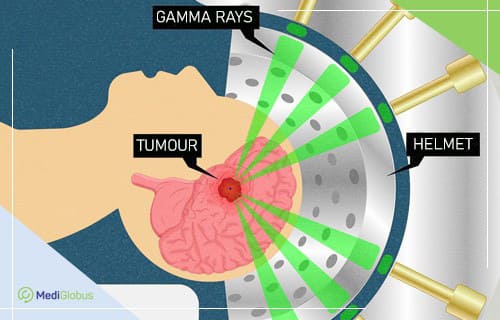1. Metastasis to the brain |
2. Diagnosis of secondary tumours |
3. Treatment options |
4. How long do patients with brain metastases live |
5. Leading clinics |
A few years ago, brain metastases were considered a verdict. Now the approach to treating such patients has changed dramatically and for the better. Thanks to the introduction of innovative neuro- and radiosurgery techniques, thousands of patients with intracerebral tumours have been able to fight the disease. How and where are brain metastases treated abroad? What technologies are used to extend the life of cancer patients and eliminate pain? To find answers to these questions, read our article.
Listen to the article:
Brain metastases – what are they?
The number of patients with brain metastases has been increasing steadily over the last decade. The situation is explained by the fact that more and more people are suffering from cancer. According to statistics from the International Agency for Research on Cancer, there were 19.3 million new cases of the disease in 2020. At the same time, the life expectancy of cancer patients is increasing, and consequently so does the probability of metastases.
Brain metastases are secondary brain tumours that consist of cells from a malignant neoplasm of another organ. They occur in 25% of all cancers.
Various tumours have metastasised to the brain. Most often the large hemispheres and the cerebellum are affected. These tumours usually originate from the following types of cancer:
lung cancer (40-60%);
breast cancer (15-30%);
melanoma (9-15%);
gastrointestinal cancer (8-12%);
kidney cancer (4-10%).
The initial sign of the development of brain metastases is pain. It comes and goes at first but later becomes constant.
As the disease progresses, other symptoms occur, like decreased vision, impaired coordination, memory problems, nausea and vomiting. How a secondary tumour will manifest itself depends on the location and size of the tumour.

How can I identify brain metastases?
Several examinations are used to detect secondary cancer foci. Magnetic resonance imaging of the brain with contrast is one of the most informative methods. It makes it possible to visualise structural changes in the brain tissue. Computerised tomography (CT), positron emission computed tomography (PET-CT), electroencephalography (EEG) and biopsy are also indicated for detecting metastases.
You can book an appointment to have your brain metastases diagnosed by contacting the coordinating doctors of the MediGlobus International Medical Platform. Our specialists will help you to choose a clinic and organise your trip.
How are brain metastases treated?

The choice of oncotherapy is shaped by the characteristics of the specific disease. Patients are initially treated with medication and chemotherapy to fight brain metastases.
Drug therapy gives a chance to control the symptoms of metastases and make life more comfortable. Steroids and anticonvulsants are prescribed for this purpose. Chemotherapy is administered together with medication. This reduces or destroys tumour foci. If the combination of medication and chemotherapy is not sufficient, doctors try other methods:
radiotherapy,
stereotactic radiosurgery (Cyberknife, Gamma Knife),
surgical intervention.
Immune and targeted therapies are available for patients with metastatic brain lesions as part of an experimental treatment. These therapies are showing good results against lung and breast cancer metastases.
To find the right programme for dealing with brain metastases and go for treatment, leave an application form on our website. Click the button below and fill in the feedback form.
Radiotherapy for brain metastases
Radiotherapy uses beams of powerful energy, such as X-rays and protons, to kill tumour cells. In the case of metastases in the brain, treatment involves irradiation of the whole organ (WBRT). This is particularly relevant for advanced breast or lung cancer. These cancers are more sensitive to radiotherapy than melanoma, renal or gastrointestinal cancers.
Indications for WBRT include the presence of multiple brain metastases and large tumours. Total radiation therapy is also used after resection of a single neoplasm. This helps to reduce the risk of recurrence of cancer cells.
It takes 10 to 15 treatments over 2 to 3 weeks to achieve the maximum therapeutic effect. WBRT is often combined with stereotactic radiosurgery.

Stereotactic radiosurgery for brain metastases
Stereotactic Radiosurgery (SRS) involves precisely targeting cancer cells with large doses of radiation. Thanks to this technology, several tumours can be treated in one session. The main prerequisite is for malformation to be less than 4 cm in size. Doctors can treat up to 10 lesions. The best results are achieved with tumours that are no larger than 2 cm in diameter.
CyberKnife and Gamma Knife are used to fight secondary cancerous lesions of the brain. The CyberKnife radiosurgery system is the gold standard for the treatment of intracerebral metastases. It can irradiate about 10 tumours at the same time. The unit adapts to the patient’s breathing and adjusts the delivery accuracy and radiation dose during the session. To achieve the desired result, 1-5 sessions of 30-90 minutes are sufficient.
GammaKnife radiosurgery has come a long way since the advent of CyberKnife. The principles of action and effectiveness of these technologies are the same, but they have significant differences. The GammaKnife loses out to the CyberKnife through its inability to adjust the direction and intensity of the gamma-ray during a session. The patient’s head must be fixed in a rigid metal frame with special screws. This involves local anaesthesia. The Cyberknife does not require immobilisation or aestheticization of the patient.
Surgery for brain metastases

Surgery for brain metastases is carried out when the tumour is solitary and large. It lasts from 4 to 6 hours. During the intervention, the maximum volume of the neoplasm is removed. Microsurgical techniques or open surgery are used for this.
Open surgery involves trepanation of the skull – temporary removal of a bone flap to gain access to the brain. Abroad, awake craniotomy is available. It allows doctors to control the function of the individual structures of the brain without damaging them.
Tumours larger than 5 cm are operated on during open surgery.
Microsurgery for brain metastases is a minimally traumatic procedure. It involves the removal of cancer cells without craniotomy, through an incision of 4-5 cm in length.
An alternative technique is to resect the tumour through the patient’s nasal sinuses.
All manipulations are performed under the supervision of Brainlab, Stryker, Medtronic, etc. neuronavigation systems. This equipment prevents damage to important structures of the brain. It functions by continuously monitoring the position of the surgical instruments. The risk of neurological deficits is minimised after these interventions.
The prognosis for the treatment of patients with brain metastases
The life expectancy of patients with brain metastases depends on the type of cancer, the number of lesions, their size and location. This is also influenced by the oncotherapy programme.
Without treatment, life expectancy for patients with brain metastases does not exceed two months. With adequate therapy, the survival rate is:
lung cancer – 7-24 months;
breast cancer – 3-36 months;
melanoma – 5-34 months;
gastrointestinal cancer – 3-17 months;
kidney cancer – 5-36 months.

Where are brain metastases treated abroad?
Summary
Metastasis to the brain indicates that cancer has progressed. The cancer cells from the primary tumour spread throughout the body and enter the brain through the bloodstream. It usually takes half a year to two years from the time a primary tumour is detected until it metastasises.
About 25% of all cancers give rise to secondary tumours in other organs. Brain metastases are most commonly diagnosed in lung cancer, melanoma, kidney cancer and stomach cancer.
The main treatments for secondary brain tumours include radiotherapy, chemotherapy, radiosurgery and surgery. The development of targeted and immune therapies for patients with brain metastases in non-small cell lung cancer, breast cancer and melanoma offers chances of survival.
B Life expectancy for patients with brain metastases without treatment does not exceed two months. If oncological treatment is given in time and in full, about 60% of patients can achieve a 3-year survival rate.
For treatment of brain metastases, patients go to Turkish, Spanish, Austrian, Israeli and Korean clinics. Notable among them are Medical Park, Koç, Sheba, Severance, Hadassah and Teknon.
Brain metastases are a serious condition that requires immediate intervention. We value our patients’ time, so we organise treatment abroad as quickly as possible.
Источники:
- National Center for Biotechnology Information
- Mayo Foundation for Medical Education and Research
- Baptist Health South Florida














